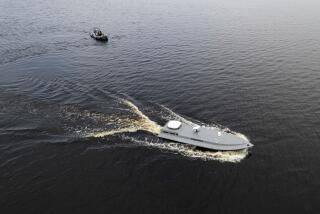Russia Rethinks 2nd-Ship Theory in Sub Sinking
MOSCOW — No fragments of a foreign submarine have been found near Russia’s sunken nuclear submarine Kursk, and officials no longer consider a collision with another vessel the most likely cause of the tragedy, Russia’s deputy prime minister said Friday.
Investigators still haven’t determined what caused an explosion that sent the Kursk to the bottom of the Barents Sea during naval exercises Aug. 12. All 118 sailors aboard died.
For months, Russian officials insisted that the most likely cause was a collision with a foreign submarine or ship. Other causes they considered were a collision with a World War II mine or a malfunction in the torpedo compartment.
None of the possibilities have been ruled out, but “none of them is dominant” any longer, Deputy Prime Minister Ilya I. Klebanov was quoted as saying by the Interfax news agency. Klebanov heads the government commission investigating the tragedy.
Submersibles inspected a 60-square-mile area of the Barents Sea floor around the Kursk but found no pieces of a foreign submarine, Klebanov said.
Russian rescuers tried for a week to get inside the Kursk, while officials insisted that at least some of the crew was still alive. But Klebanov said Friday that most of the sailors were killed in the seconds following the explosion--confirming earlier conclusions by independent experts.
“By the time the vessel hit the bottom, almost all of the crew was already gone,” he told reporters.
An operation to retrieve the crew’s remains is to begin late next week. But the divers will not be able to reach many of the bodies because of damage to the vessel, Russian officials have said.
Although Russian deep-water capsules have examined the Kursk and recorded “catastrophic destruction,” Klebanov said, the submarine poses no threat of radioactive leaks. Special devices had been fitted to monitor the situation inside the wreck, he said.
For the first time, Klebanov confirmed speculation in both the Russian and Western press that the Kursk had been due to test a liquid fuel-powered torpedo when the explosion occurred.
More to Read
Sign up for Essential California
The most important California stories and recommendations in your inbox every morning.
You may occasionally receive promotional content from the Los Angeles Times.










